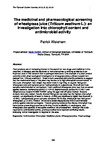The medicinal and pharmacological screening of wheatgrass juice (Triticum aestivum L.): an investigation into chlorophyll content and antimicrobial activity
| dc.contributor.author | Wakeham, P. | |
| dc.date.accessioned | 2019-05-16T09:24:39Z | |
| dc.date.available | 2019-05-16T09:24:39Z | |
| dc.date.issued | 2013 | |
| dc.identifier.citation |
Wakeham, P. (2013) 'The medicinal and pharmacological screening of wheatgrass juice (Triticum aestivum L.): an investigation into chlorophyll content and antimicrobial activity', The Plymouth Student Scientist, 6(2), p. 20-30. | en_US |
| dc.identifier.issn | 1754-2383 | |
| dc.identifier.uri | http://hdl.handle.net/10026.1/14033 | |
| dc.description.abstract |
Plant products are of increasing interest in the search for new drugs and medicines in the treatment of disease; and the discovery of new alternatives to existing antibiotics is an important area of this research due to pathogen resistance. One example of a plant product currently under pharmacological investigation is wheatgrass juice; a dietary supplement derived from Triticum aestivum L. There is both anecdotal and scientific evidence to suggest that the medicinal efficacy of this plant may be due to its high chlorophyll concentrations. In this study chlorophyll fresh weight was determined in mg/100g for organic field grown wheatgrass juice and samples grown hydroponically in a glasshouse. Broccoli and Kale samples were included for comparison. Fresh undiluted wheatgrass juice was then screened against bacteria: Escherichia coli NCTC 10418; Staphylococcus aureus NCTC 6571 and Streptococcus mutans NCIMB 702062, using the agar well diffusion method. Acetone extracts were also tested. Results showed field grown samples had the highest chlorophyll content, not significantly different to Kale (p =0.834) and significantly higher than Broccoli (p <0.001). Hydroponically grown samples contained 73.4% less chlorophyll than field grown wheatgrass (p <0.001). None of the extracts tested displayed any kind of antimicrobial activity against selected pathogens. There is growing evidence that dietary chlorophyll may have cancer preventing properties by limiting the bio-availability of carcinogens, and wheatgrass juice appears to be a good source of this phytopigment. Although this study reported no antimicrobial activity, previous studies have reported conflicting results, indicating further investigation is required in this area. | en_US |
| dc.language.iso | en | en_US |
| dc.publisher | University of Plymouth | |
| dc.rights | Attribution 3.0 United States | * |
| dc.rights.uri | http://creativecommons.org/licenses/by/3.0/us/ | * |
| dc.subject | antimicrobial | en_US |
| dc.subject | chlorophyll | en_US |
| dc.subject | medicinal plants | en_US |
| dc.subject | wheatgrass juice | en_US |
| dc.subject | pharmacology | en_US |
| dc.title | The medicinal and pharmacological screening of wheatgrass juice (Triticum aestivum L.): an investigation into chlorophyll content and antimicrobial activity | en_US |
| dc.type | Article | |
| plymouth.issue | 2 | |
| plymouth.volume | 6 | |
| plymouth.journal | The Plymouth Student Scientist |



